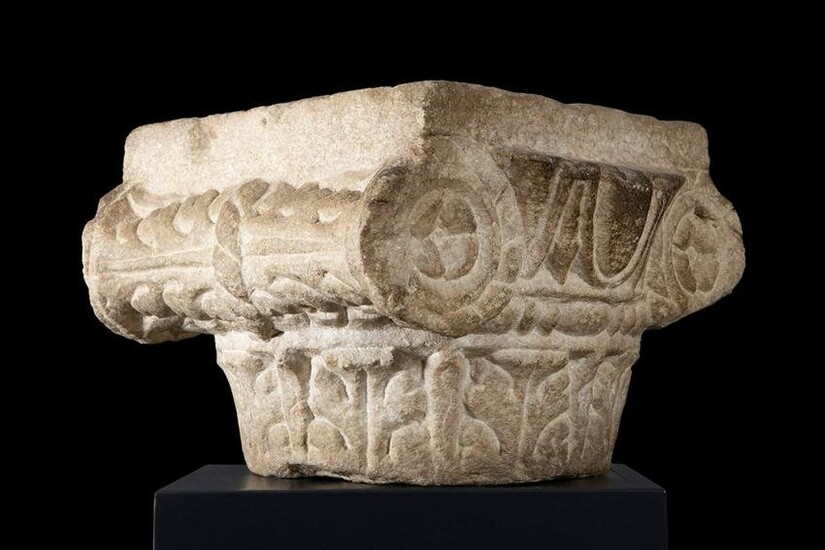Ionic capital; Roman Empire, 1st-2nd century AD. Carved
Ionic capital; Roman Empire, 1st-2nd century AD.
Carved marble.
Size: 24 x 37 x 40 cm.
Roman capital in carved marble. The carving follows the foliated decoration with double volutes characteristic of the Ionic order, between which are arranged rows of ovals and darts. Below the volutes, a crown of skilfully carved acanthus surrounds the capital. Roman architecture took its models from the Greek art of Antiquity, but always adapting these examples to its own requirements and particularities, both in terms of function and aesthetics, giving rise to a series of variants and important differences, although it is possible to speak of the existence of the three Greek architectural orders in Roman art, to which the Tuscan (derived from the Greek Doric) and the composite can be added. A comparison of the present capital (in which the Ionic and Corinthian orders merge to some extent) with other ancient Greek Ionic capitals, such as those in the 6th-century Temple of Artemis in Ephesus or, a purer variant, in the Erechtheus of the Acropolis in Athens, shows the differences between Greek works of this type and Roman ones. The volutes are not arranged in line with the body of the capital, and the strings of beads do not appear where they usually do in Greek Ionic volutes, for example. In this sense, the capital shown is closer to the composite order. Note the similarity with preserved Roman capitals such as the one from the Triumphal Arch of Septimius Severus (Rome, 203 AD), those preserved from the Balbi or Balbo Theatre in Rome, with the volutes worked in the form of scrolls in a manner very similar to those that would probably date from Hadrian's time.
Estimate
Time, Location
Auction House
Ionic capital; Roman Empire, 1st-2nd century AD.
Carved marble.
Size: 24 x 37 x 40 cm.
Roman capital in carved marble. The carving follows the foliated decoration with double volutes characteristic of the Ionic order, between which are arranged rows of ovals and darts. Below the volutes, a crown of skilfully carved acanthus surrounds the capital. Roman architecture took its models from the Greek art of Antiquity, but always adapting these examples to its own requirements and particularities, both in terms of function and aesthetics, giving rise to a series of variants and important differences, although it is possible to speak of the existence of the three Greek architectural orders in Roman art, to which the Tuscan (derived from the Greek Doric) and the composite can be added. A comparison of the present capital (in which the Ionic and Corinthian orders merge to some extent) with other ancient Greek Ionic capitals, such as those in the 6th-century Temple of Artemis in Ephesus or, a purer variant, in the Erechtheus of the Acropolis in Athens, shows the differences between Greek works of this type and Roman ones. The volutes are not arranged in line with the body of the capital, and the strings of beads do not appear where they usually do in Greek Ionic volutes, for example. In this sense, the capital shown is closer to the composite order. Note the similarity with preserved Roman capitals such as the one from the Triumphal Arch of Septimius Severus (Rome, 203 AD), those preserved from the Balbi or Balbo Theatre in Rome, with the volutes worked in the form of scrolls in a manner very similar to those that would probably date from Hadrian's time.



